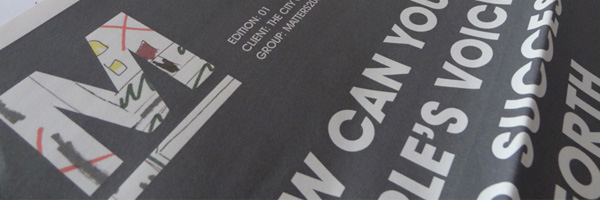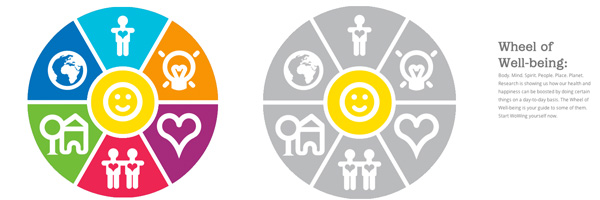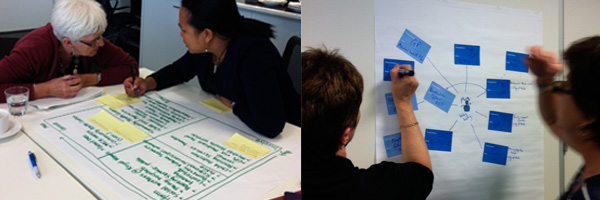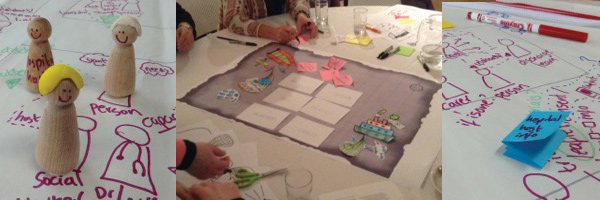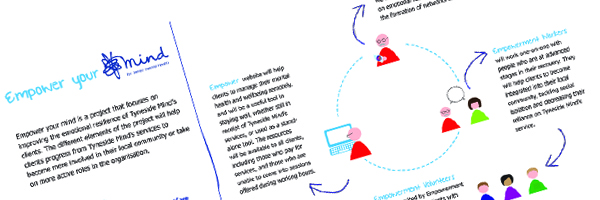The research project featured six case studies, covering a wide range of sectors, types of interventions and length of time. Below are summaries of the six case studies. Full complete case studies report are located in the final report.
1. THE MATTER
The Matter is a new service designed and developed by Snook, a Scottish service design agency in partnership with Young Scot with further support from Firstport and The City of Edinburgh Council (the Council), aimed at developing skills to improve employability.
Context
The Matter was selected as one of the projects supported by the ‘Working Well Challenge’ in 2012, run by Design Council in partnership with Nominet Trust as the key funder. The focus of the challenge was to design and launch new digital products and services that support young people to develop their talents, focus on problem solving and identify solutions in order to improve their employability. Snook developed and pitched the idea to the Design Council Working Well Challenge. The Matter prototype was then piloted with a group of young people found through Edinburgh Council’s Total Craigroyston project that Snook was working with at that time. Tim Packer from Edinburgh Council asked The Matter to focus on how young people’s voices could be heard during the planning process of the Forth Neighbourhood Partnership. The idea of a newspaper emerged as a vehicle to capture and communicate responses from the community and the group of young people (found through the Total Craigroyston project) formed the editorial team. The newspaper was supported by a digital platform to gather information and share resources. The resulting Matter newspaper enabled young people’s views to be represented to the Council in an open, transparent and direct manner.
Impact
It is particularly evident in this case study that the intended (and unintended) impacts of a design-led approach for the different stakeholders have been rich and varied. For the Council, the main impact has been their exposure to more effective (co-created, transparent and creative) forms of consultations that has helped them re-engage disconnected young people in the Craigroyston area. For Snook (the service designers), it has offered them a way to trial an approach to develop new products and services. The community has benefited from having a resource (The Matter newspaper) as a vehicle to raise awareness and generate debate about the issues in the community. The project also offered The Matter’s editorial team an opportunity to improve their employability skills by developing their research, communication and writing skills as well as giving them a voice in the local Community Planning Process. An unintended impact became evident when a further 2nd and 3rd edition of the Matter newspaper was self-initiated by the youth group even though funding for the project had ended. The newspaper continues to be used as a resource for the community and each edition is focused on different issues every time.
2. WHEEL OF WELL-BEING
The Wheel of Well-Being is a mental health promotion initiative that has developed over a six-year period through a collaboration between Uscreates and the mental health promotion team at South London and Maudsley NHS Foundation Trust (SLaM).
Context
Uscreates is a strategic consultancy based in London, which focusses on delivering social value. SLaM is one of the UK’s largest mental health trusts, providing a range of in-patient and community mental health services to one million residents in SE London and beyond. In 2008, they began working together to develop a framework to improve public understanding of the integrated nature of well-being and to promote positive action to improve mental health. Between 2008 and 2009, their initial framework evolved into the current six-sectioned Wheel of Well-Being (WoW), incorporating the “Five Ways to Well-being” in the process (nef, 2008). The framework aimed to communicate and encourage the uptake of positive actions that evidence showed could improve both individual and collective well-being. The WoW framework started out as a communication and branding tool for the Well London Do-It-Yourself Happiness project. Since 2009 it has grown to encompass a series of practical activities, tools and resources, co-developed by local residents involved in the Well London health improvement programme.
Over the last six years, Uscreates and SLaM have worked together to co-design and tailor the WoW framework to meet a range of needs across London, the UK and beyond. The ongoing partnership has generated a series of outputs including the Wheel of Well-Being website, a collection of practical resources and activities (www.wheelofwellbeing.org); a DIY Happiness board game, which encourages players to share well-being tips; a community-event planning toolkit; and a series of training and development initiatives which include DIY Happiness Workshops and happier@work, an approach to workplace well-being which tailors interventions to improve well-being at individual, team and organisational levels.
Impact
This case study has been useful to understand the potential longer-term outcomes of a design-led approach in the development of new products and services. The impact of a design-led approach is evident in a number of ways, including the evolution of a more entrepreneurial business model of mental health promotion, to maximise revenue generated from the range of new products and services. The development of this model has helped create a sustainable programme of work, which has been running for six years. Initially designed as a solution to a communication and branding challenge, the partnership has co-created a framework and strategy that underpins and enables the creation of bespoke tools and services for other organisations. For Uscreates, the outcome has been a change in the relationship with SLaM and in the way they work with commissioners; moving away from a more conventional ‘client/consultancy’ model to one of a collaborative partnership.
3. PATCHWORK
Patchwork, a web-based platform was created to improve services for vulnerable children and adults. It was piloted in the UK and replicated in Australia in two locations – the Municipal Association of Victoria (MAV) and Department of Family and Community Services, New South Wales (NSW).
Context
Patchwork is a web-based platform designed and developed by FutureGov (a design, technology and change management agency) to assist in team collaboration and information sharing around safeguarding children and vulnerable adults. Patchwork was developed over a number of years since 2009, with support from Nesta and in collaboration with a diverse range of services and practitioners, parents, carers and researchers. Essentially, it is a web-based telephone directory connecting agencies and individuals who provide services and enabling earlier interventions and better outcomes. This case study focuses on Patchwork’s implementation across two different organisations and sites, the Municipal Association of Victoria (MAV) and the Department of Family and Community Services, New South Wales (NSW), Australia. The implementation in NSW had only just begun at the start of the research, but the MAV site has been running since July 2013. Within 3 months of its launch, the MAV site already has 300 clients, and 270-300 agents and practitioners representing 270 different organisations signed-up on the system.
Impact
The Patchwork project illustrates what FutureGov terms the ‘Trojan Mouse’ effect. Although Patchwork is, on the surface, a technological solution, its most powerful impact has been on culture change. The simple solution reveals the often-hidden network around a vulnerable client, and for the commissioners, has challenged current practices around social care. The platform offers a practitioner-focused solution that helps connect the support network of a person from different organisations. It has also given practitioners an easier and direct way to connect with other practitioners, by helping them navigate complex and political organisations. The ongoing challenge for FutureGov is to reframe Patchwork’s implementation strategy from a technology strategy to one that is about engagement and communication.
4. BETTER BY DESIGN
Better by Design is a two-year design-led programme aimed at supporting a better and more sustainable third sector across Scotland. Through this case study we are investigating the impact and value a design-led approach has in supporting and enabling a change management process.
Context
In 2013, the Big Lottery Fund Scotland commissioned Taylor Haig and The Young Foundation to deliver Better by Design, a two-year initiative to introduce design approaches to support 15 third sector organisations to increase their social impact and be more sustainable in the longer term. The initiative offered expert, bespoke support from a multi-disciplinary team operating within the framework of a design-led approach. The main focus of the programme is to put users at the centre of their services, improve outcomes and make organisations more sustainable. For the purpose of the AHRC project, we interviewed Taylor Haig, whose focus was on systems change within organisations, and Billy Sloan, CEO of Scarf, one of the 15 voluntary sector organisations taking part in Better by Design. Scarf is a social enterprise that delivers services to alleviate fuel poverty and develop sustainable living across Scotland. They worked closely with Taylor Haig to shift from a top-down and hierarchical culture, to one that is open, innovative and empowered. Compared to the Patchwork project, this was a much more explicit example of a design-led approach being used to support and enable a change management process. As a result, the relationship between the design team and the client was qualitatively different. Taylor Haig’s role was to offer a fresh perspective and be a ‘critical friend’.
Impact
The Scarf office was redesigned to encourage more openness and transparency; a simple change involved the installation of a large blackboard in the corridor to encourage staff to share and vote on ideas for improvement. The design approach also enabled Scarf to formalise and clarify their thinking around the customer journey and focus on designing ‘with’ the customer. Scarf’s CEO describes a design-led approach as “simply what we do now” as opposed to their previous reactive approach.
5. EMPOWER YOUR MIND
Empower Your Mind is a project that focuses on improving the emotional resilience of Tyneside Mind’s clients. The different elements of the project help clients progress from Mind’s services to become more involved in their local community or take on more active roles in the organisation.
Context
Tyneside Mind is one of a network of 152 separate Mind charities across England and Wales, working collaboratively with National Mind, focused on improving mental health. Their framework is centred on well-being, recovery, resilience and prevention. In 2012 Laura Warwick, a Service Designer from Northumbria University was embedded in the organisation to work alongside staff and service users at Tyneside Mind for two months. Laura assisted staff to undertake research with potential and existing service users using ‘persona’ toolkits. The valuable insights were then used to shape the Empower Your Mind project, which fundamentally altered the relationship between the organisation and service user. The building of a strong relationship between business and service design, led to them winning a Reaching Communities Grant of £426,000 in 2013 which created four additional posts and supported their service redevelopment.
Impact
This case study has been useful in understanding how a relatively short-term, but focused, service design project has not only led to an immediate outcome in the form of a substantial grant, but also helped change how the organisation operates. Using a service design process enabled Tyneside Mind to refocus their service delivery on the needs of their clients, rather than on those of the organisation. The holistic user research helped Tyneside Mind to recognise how their service offers could change to better meet the needs of their clients, and realign their offers around shared goals, values and direction.
6. VISIONING FUTURE CARE PLANS
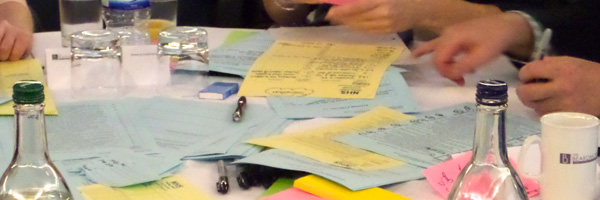
Visioning Future Care Plans is part of a series of interventions presented to a diverse range of stakeholders within NHS Scotland in the form of workshops. Part of a larger programme, the workshops were organised in response to legislative changes aimed at integrating Health and Social Care. This case study helped us to understand the bigger context of integrating a series of design-led workshops to NHS stakeholders to unravel what impact and value design techniques brought to those involved and their lasting legacy.
Context
This case study centres around a one-hour ‘Future Visioning Session’, which took place during a series of one-day ‘Integrated Care Learning Events’ across Scotland in 2013. The aim was to bring together a wide range of practitioners for joint discussions about improvements, innovation and transformation in Integrated Care, with the view to sharing learning and creating future visions to be further developed.
Open Change, a Scottish based partnership which helps organisations think creatively about the future, was commissioned by the Scottish Government’s Quality and Efficiency Support Team (QuEST) to facilitate three design-led creative thinking sessions. Focussing on transformation, the team worked with participants in Primary Care, Secondary Care, Acute teams, Community teams and third sector organisations, using a ‘Tomorrow’s News’ method to generate future stories of how service users experience might be improved through services working together The event was an opportunity for teams to mix, giving them the chance to collaborate, plan, design and work together, sharing their expertise. The Open Change team used journey mapping, the POINT framework and storytelling to enable participants to imagine future scenarios, exposing participants to different ways of thinking, removing constraints and generating radical ideas.
Impact
Although only focused on a very short intervention, it was evident from the interviews that a longer-term impact has been achieved through follow-up projects looking to bring design-led approaches to facilitate individual health and social care teams. There are also plans to adopt similar techniques locally to reshape other models of care.
.

